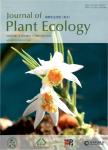Spatial isolation and genetic differentiation in naturally fragmented plant populations of the Swiss Alps
作者机构:Institute of BotanyUniversity of BaselSchonbeinstrasse 6CH-4056BaselSwitzerland Institute of Plant SciencesUniversity of BernAltenbergrain21CH-3013BernSwitzerland Institute for Terrestrial EcosystemsEcosystem ManagementETH ZurichUniversitatstrasse 168092 ZurichSwitzerland
出 版 物:《Journal of Plant Ecology》 (植物生态学报(英文版))
年 卷 期:2008年第1卷第3期
页 面:149-159页
核心收录:
学科分类:0710[理学-生物学] 071001[理学-植物学] 0907[农学-林学] 07[理学] 0713[理学-生态学]
主 题:Campanula thyrsoides Epilobium fleischeri Geum reptans isolation by distance molecular diversity
摘 要:The effect of anthropogenic landscape fragmentation on the genetic diversity and adaptive potential of plant populations is a major issue in conservation biology.However,little is known about the partitioning of genetic diversity in alpine species,which occur in naturally fragmented habitats.Here,we investigate molecular patterns of three alpine plants(Epilobium fleischeri,Geum reptans and Campanula thyrsoides)across Switzerland and ask whether spatial isolation has led to high levels of population differentiation,increasing over distance,and a decrease of within-population variability.We further hypothesize that the contrasting potential for long-distance dispersal(LDD)of seed in these species will considerably influence and explain diversity partitioning.Methods For each study species,we sampled 20–23 individuals from each of 20–32 populations across entire Switzerland.We applied Random Amplified Polymorphic Dimorphism markers to assess genetic diversity within(Nei’s expected heterozygosity,He;percentage of polymorphic bands,Pp)and among(analysis of molecular variance,Ust)populations and correlated population size and altitude with within-population diversity.Spatial patterns of genetic relatedness were investigated using Mantel tests and standardized major axis regression as well as unweighted pair group method with arithmetic mean cluster analyses and Monmonier’s algorithm.To avoid known biases,we standardized the numbers of populations,individuals and markers using multiple random reductions.We modelled LDD with a high alpine wind data set using the terminal velocity and height of seed release as key parameters.Additionally,we assessed a number of important life-history traits and factors that potentially influence genetic diversity partitioning(e.***.breeding system,longevity and population size).Important findings For all three species,we found a significant isolation-by-distance relationship but only a moderately high differentiation among populations(Ust:22.7,14.8 and 16.8%,for E.fleischeri,G.reptans and C.thyrsoides,respectively).Within-population diversity(He:0.19–0.21,Pp:62–75%)was not reduced in comparison to known results from lowland species and even small populations with50 reproductive individuals contained high levels of genetic diversity.We further found no indication that a high long-distance seed dispersal potential enhances genetic connectivity among populations.Gene flow seems to have a strong stochastic component causing large dissimilarity between population pairs irrespective of the spatial distance.Our results suggest that other life-history traits,especially the breeding system,may play an important role in genetic diversity partitioning.We conclude that spatial isolation in the alpine environment has a strong influence on population relatedness but that a number of factors can considerably influence the strength of this relationship.



